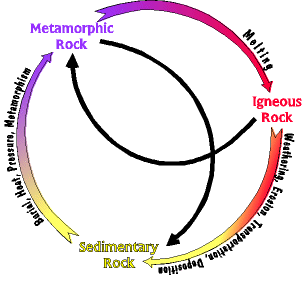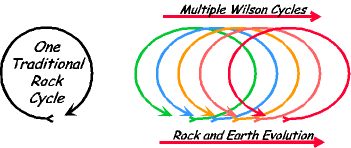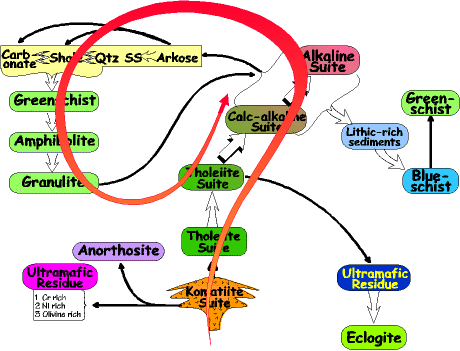
|
Jump Ahead to Specific Tectonic Rock Cycle Stages How Much Do You Understand - A Self Test Tectonic Rock Cycle Detail I-Generation of mafic oceanic crust. II-Generation of intermediate/felsic igneous rocks III-Generation of high P/high T ecolgite IV-Generation of lithic rich sediments V-Generation of high P/low T Blueschist VIa-Generation of Arkosic Sediments VIb-Generation of Quartz/ Lithic/ Feldspar Sediments VII-Generation of Quartz/ Shale/ Limestone Sediments VIII-Barrovian Metamorphism IX-Generation of Migmatite
Links to Related Sites Wilson Cycle Home Page Page of Wilson Cycle cross sections Igneous Rock Home Page This site was put together for GenSci 102A: Environment Earth. The material is copyrighted (text, images, etc.), and can not be used without permission of the copyright owner. For details, please contact Lynn S. Fichter © 1999 (Fichtels@jmu.edu) Department of Geology and Environmental Studies (Geology home page http://csm.jmu.edu/) James Madison University, Harrisonburg, VA 22807 Spring, 1999 This page is adapted from the following article: Fichter, Lynn S., 1996, Tectonic Rock Cycles: Journal of Geoscience Education, Vol. 44, pp 134-148. |
Does the Earth Cycle, Or Has It Evolved Cyclically?
The earth is an open system, and it dissipates energy. The energy comes from the Earth's molten interior, and has kept it tectonically active for 4.5 billion years, and will probably continue for another 4-5 billion years into the future when, finally, the heat supply will run out, and the earth will die. Of course, by that time the sun will enter into its red giant phase and the Earth will be burned to a crisp anyway.But it is this energy from the interior that has driven the Earth's physical/chemical evolution, and been ultimately responsible for all the rocks, continents, mountains, foreland basins, etc. Without it the earth would be like the moon or Mars, geologically dead and in equilibrium. All of these rock and tectonic features on Earth reflect the underlying principle not only of geology but the universe: "minerals and rocks are stable only under the conditions at which they form; change the conditions and the rocks change too." The Wilson Cycle is the simplest tectonic model we have of how the earth works, and dissipates its interior energy. It may not seem that simple, but in fact the Wilson Cycle leaves out most of the details, complications and exceptions which exist. But if we could we would like an even simpler model, one that quintessentially summarizes what is true about the earth.  The simplest model we have of the earth is the rock cycle (right). It summarizes the core concept of geology: all rocks are related to each other, and can be transformed one to the other. The cycle is the most theoretically abstract description of these rock relationships. It incorporates or is expandable to all rock processes, but does not necessarily specify or justify them. It also suggests the pathways by which one rock can transform into another, but does not explicate the necessary conditions under which these transformations take place. In geology it is the closest thing we have to E=mc2 (encompassing everything without directly explicating anything) . . . or is it?
The simplest model we have of the earth is the rock cycle (right). It summarizes the core concept of geology: all rocks are related to each other, and can be transformed one to the other. The cycle is the most theoretically abstract description of these rock relationships. It incorporates or is expandable to all rock processes, but does not necessarily specify or justify them. It also suggests the pathways by which one rock can transform into another, but does not explicate the necessary conditions under which these transformations take place. In geology it is the closest thing we have to E=mc2 (encompassing everything without directly explicating anything) . . . or is it?The problem with the traditional rock cycle is that it implies that rocks just cycle endlessly from one to the other. The drawing above expresses this cyclical nature (rock cycle illustrations come in endless variety; this is a very simple stripped down version.) It also expresses the view of the 19th century Uniformitarian school of thinking, captured best by James Hutton when he said the earth has "no vestige of a beginning, and no prospect of an end." He envisioned earth processes going round and round but never getting anywhere, never evolving. The Wilson cycle, however, contains an evolutionary component: that is, it is not just cyclical, but it is cyclical with direction. For example compare the Wilson Cycle Stage A continent with the Wilson Cycle Stage I continent. Stage I is a bigger continent containing more felsic igneous rock because of all the rock evolution taking place in the Wilson cycle. The direction we see in the earth's evolution shows up in a number of ways, the increasing diversification of rocks with time, the increasing size of the continental masses (increasing volume of granite), and the changing tectonic provinces we see. Of course, this immediately brings up the question, is this directional evolution of the earth also progress?. This is a sticky question because "progress" implies a predefined goal toward which the progress is heading. From a scientific viewpoint there is no "progress", there is just change. But the earth is an open, dissipative system, and it does evolve, as the Wilson Cycles illustrates. Our work is to understand and explicate the processes leading to that evolution. So, if we are looking for one simple ideal model of how the earth operates, avoiding all the technical details, we need a different model than the basic rock cycle. The Tectonic Rock Cycle is such a model (below). Here we see in one diagram a complete summary of the processes that lead to the evolution of the physical earth. The Tectonic Rock Cycle
Look at this model spatially, ignoring its details. Just look for the major paths of flow through the cycle, following the arrows. Take a highlighter and draw a line showing those major paths. Observe the one that begins with the parent rock (komatiite suite), goes through the tholeiite »calc-alkaline »alkaline suites, through the sedimentary processes (yellow box), through the Barrovian metamorphism (greenschist »amphibolite »granulite), and twisting back toward the calcalkaline and alkaline suites. The path forms a question mark shape, and it does not cycle back on itself completely. Instead, beginning with a mafic/ultramafic parent rock earth processes fractionate, and fractionate, and fractionate this material, each time squeezing out a rock whose composition gets ever lower on Bowen's Reaction Series. Even sedimentary processes fractionate the rocks chemistry. Observe that the sedimentary rocks in the yellow box when metamorphosed to the melting state result in an igneous rock low on the reaction series. Thus, the tectonic rock is operating like the drawings below right. The basic rock cycle on the left just goes round and round without getting anywhere. The tectonic rock cycles (Wilson Cycles) on the right not only go round they also go ahead a little each cycle.  The Earth is not just a rock cycle, it is an evolutionary rock cycle. So, to answer the question, Does the Earth Cycle, Or Has It Evolved Cyclically? we conclude that it evolves cyclically through Wilson Cycles, each cycle adding a little more felsic igneous rock to the planet, and not incidently increasing the size of the continents. The logic and processes behind the tectonic rock cycle is explored in more detail through the link below. |
| Last Update: 9/05/00 | e-mail: (Fichtels@jmu.edu) |
